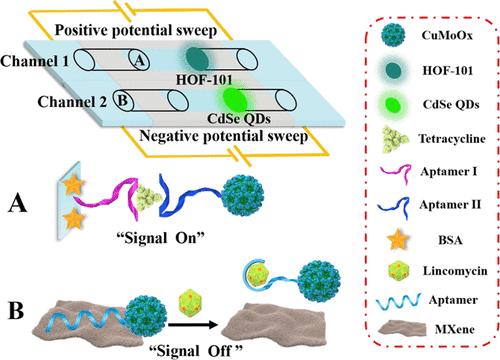当前位置:
X-MOL 学术
›
Anal. Chem.
›
论文详情
Our official English website, www.x-mol.net, welcomes your feedback! (Note: you will need to create a separate account there.)
Spatial-Potential-Color-Resolved Bipolar Electrode Electrochemiluminescence Biosensor Using a CuMoOx Electrocatalyst for the Simultaneous Detection and Imaging of Tetracycline and Lincomycin
Analytical Chemistry ( IF 7.4 ) Pub Date : 2024-04-25 , DOI: 10.1021/acs.analchem.4c00388 Hongkun Li 1 , Qianqian Cai 1 , Yuehui Wang 1 , Guifen Jie 1 , Hong Zhou 1
Analytical Chemistry ( IF 7.4 ) Pub Date : 2024-04-25 , DOI: 10.1021/acs.analchem.4c00388 Hongkun Li 1 , Qianqian Cai 1 , Yuehui Wang 1 , Guifen Jie 1 , Hong Zhou 1
Affiliation

|
A spatial-potential-color-resolved bipolar electrode electrochemiluminescence biosensor (BPE-ECL) using a CuMoOx electrocatalyst was constructed for the simultaneous detection and imaging of tetracycline (TET) and lincomycin (LIN). HOF-101 emitted peacock blue light under positive potential scanning, and CdSe quantum dots (QDs) emitted green light under negative potential scanning. CuMoOx could catalyze the electrochemical reduction of H2O2 to greatly increase the Faradic current of BPE and realize the ECL signal amplification. In channel 1, CuMoOx-Aptamer II (TET) probes were introduced into the BPE hole (left groove A) by the dual aptamer sandwich method of TET. During positive potential scanning, the polarity of BPE (left groove A) was negative, resulting in the electrochemical reduction of H2O2 catalyzed by CuMoOx, and the ECL signal of HOF-101 was enhanced for detecting TET. In channel 2, CuMoOx-Aptamer (LIN) probes were adsorbed on the MXene of the driving electrode (DVE) hole (left groove B) by hydrogen-bonding and metal-chelating interactions. LIN bound with its aptamers, causing CuMoOx to fall off. During negative potential scanning, the polarity of DVE (left groove B) was negative and the Faradic current decreased. The ECL signal of CdSe QDs was reduced for detecting LIN. Furthermore, a portable mobile phone imaging platform was built for the colorimetric (CL) detection of TET and LIN. Thus, the multiple mode-resolved detection of TET and LIN could be realized simultaneously with only one potential scan, which greatly improved detection accuracy and efficiency. This study opened a new technology of BPE-ECL sensor application and is expected to shine in microchips and point-of-care testing (POCT).
中文翻译:

使用 CuMoOx 电催化剂的空间电位颜色分辨双极电极电化学发光生物传感器同时检测四环素和林可霉素并成像
构建了一种使用 CuMoOx 电催化剂的空间电位颜色分辨双极电极电化学发光生物传感器 (BPE-ECL),用于同时检测和成像四环素 (TET) 和林可霉素 (LIN)。 HOF-101在正电位扫描下发出孔雀蓝光,CdSe量子点(QD)在负电位扫描下发出绿光。 CuMoOx可以催化H 2 O 2电化学还原,大大增加BPE的法拉第电流,实现ECL信号放大。在通道1中,通过TET双适体夹心法将CuMoOx-Aptamer II (TET)探针引入BPE孔(左凹槽A)。正电位扫描时,BPE(左槽A)的极性为负,导致CuMoOx催化H 2 O 2电化学还原,增强HOF-101的ECL信号以检测TET。在通道 2 中,CuMoOx-Aapter (LIN) 探针通过氢键和金属螯合相互作用吸附在驱动电极 (DVE) 孔(左侧凹槽 B)的 MXene 上。 LIN与其适配体结合,导致CuMoOx脱落。负电位扫描时,DVE(左槽B)极性为负,法拉第电流减小。为了检测 LIN,降低了 CdSe QD 的 ECL 信号。此外,还构建了便携式手机成像平台,用于TET和LIN的比色(CL)检测。因此,仅需一次电位扫描即可同时实现TET和LIN的多模式分辨检测,大大提高了检测精度和效率。该研究开启了BPE-ECL传感器应用新技术,有望在微芯片和即时检测(POCT)领域大放异彩。
更新日期:2024-04-25
中文翻译:

使用 CuMoOx 电催化剂的空间电位颜色分辨双极电极电化学发光生物传感器同时检测四环素和林可霉素并成像
构建了一种使用 CuMoOx 电催化剂的空间电位颜色分辨双极电极电化学发光生物传感器 (BPE-ECL),用于同时检测和成像四环素 (TET) 和林可霉素 (LIN)。 HOF-101在正电位扫描下发出孔雀蓝光,CdSe量子点(QD)在负电位扫描下发出绿光。 CuMoOx可以催化H 2 O 2电化学还原,大大增加BPE的法拉第电流,实现ECL信号放大。在通道1中,通过TET双适体夹心法将CuMoOx-Aptamer II (TET)探针引入BPE孔(左凹槽A)。正电位扫描时,BPE(左槽A)的极性为负,导致CuMoOx催化H 2 O 2电化学还原,增强HOF-101的ECL信号以检测TET。在通道 2 中,CuMoOx-Aapter (LIN) 探针通过氢键和金属螯合相互作用吸附在驱动电极 (DVE) 孔(左侧凹槽 B)的 MXene 上。 LIN与其适配体结合,导致CuMoOx脱落。负电位扫描时,DVE(左槽B)极性为负,法拉第电流减小。为了检测 LIN,降低了 CdSe QD 的 ECL 信号。此外,还构建了便携式手机成像平台,用于TET和LIN的比色(CL)检测。因此,仅需一次电位扫描即可同时实现TET和LIN的多模式分辨检测,大大提高了检测精度和效率。该研究开启了BPE-ECL传感器应用新技术,有望在微芯片和即时检测(POCT)领域大放异彩。



























 京公网安备 11010802027423号
京公网安备 11010802027423号